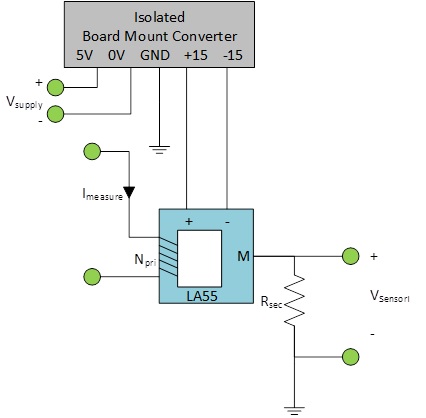
- The recommended current sensor is the LEM LA55. It is a closed loop hall effect sensor capable of measuring DC and AC. It can measure up to 50 A or 100 A (2 different design). However, for this tutorial, the design is based on 50 A.
- The number of primary turns, Npri, depends on the maximum measured current, Imeasure(max). The Imeasure(max) needs to be below 50 A.
Npri <= 50 / Imeasure(max)
where Npri needs to be natural number (1,2,3,4,5,…….) - The Rsec needs to be 30 Ω to 330 Ω based on the datasheet. If the Rsec becomes higher, the reading becomes non-linear. It is recommended to choose not more than 300 Ω to obtain linear reading.
- The Rsec depend on the maximum voltage rating for analogue to digital converter (ADC) for the hardware platform.
Rsec = 2000 Vsensor(max) / Imeasure(max) / Npri
30 Ω <= Rsec <= 330 Ω
If over the limit, the maximum Rsec (330 Ω) is used:
Vsensor(actual) = Imeasure(max) Npri Rsec / 2000
- Since the dSPACE ds1104 has 10V ADC, the LV25 are out of range of Vsensor(max). The LEM LV25 still can be used for the dSPACE ds1104. However, the sensitivity of the measurement is reduced. As a result, the accuracy of the measurement becomes lower. It is recommended to use 300 Ω for Rsec in dSPACE ds1104 application with sensitivity high reduction. However, this is good safety factor if measurement overshoot occurs. To improve the sensitivity of the measurement, the amplifier circuit is needed.
- Rsec is recommended to have low tolerance (check the forth colour band at the resistance) and 0.5 W or 1.0 W rating to increase measurement accuracy and reduce the effect from temperature change.
- Besides LA55, the LEM LY version is also suitable for the dSPACE ds1104. It is a cheaper option because it is an open loop sensor. It also has a non-adjustable rating. For example LEM LY05 only capable of measuring the current up to 5 Arms.

